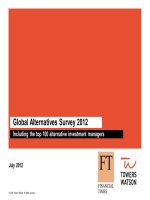Reuters.business.insights.the.top.10.global.insura nce.companies.sept.2004.ebook-tlfebook
Bạn đang xem bản rút gọn của tài liệu. Xem và tải ngay bản đầy đủ của tài liệu tại đây (605.08 KB, 131 trang )
FINANCE
THE TOP 10 GLOBAL INSURANCE
COMPANIES
Increasing profitability, market share and competitive
edge
By Barbara Kubis-Labiak
TLFeBOOK
ii
Barbara Kubis-Labiak
Barbara has a BA (Hons) in Business and Management and is currently at the end of her
MSc in International Finance degree. Barbara started her career working as an intern for
the European Commission in Brussels, and then in 1999 she joined Datamonitor
Financial Services department as an analyst. Barbara's work at Datamonitor involved
various projects and reports, including the FinTab project, where she helped to develop
an online data resource covering the insurance, banking, investments and payment cards
sectors. Barbara also authored a number of reports: Retirement Provision in Germany
2001-2008, Retirement Provision in Germany 2002, European Mutual Funds 2001, UK
Wealth Management, Distribution of life insurance and pensions in Europe 2002 and
Central and Eastern European Life and Pensions 2002, as well as consultancy projects,
for example Motor insurance distribution in central Europe, Competitors in occupational
pensions in Germany, Bausparkassen in Germany and many others.
Copyright © 2004 Business Insights Ltd
This Management Report is published by Business Insights Ltd. All rights reserved.
Reproduction or redistribution of this Management Report in any form for any purpose is
expressly prohibited without the prior consent of Business Insights Ltd.
The views expressed in this Management Report are those of the publisher, not of Business
Insights. Business Insights Ltd accepts no liability for the accuracy or completeness of the
information, advice or comment contained in this Management Report nor for any actions
taken in reliance thereon.
While information, advice or comment is believed to be correct at the time of publication, no
responsibility can be accepted by Business Insights Ltd for its completeness or accuracy.
Printed and bound in Great Britain by MBA Group Limited, MBA House, Garman Road,
London N17 0HW. www.mba-group.com
TLFeBOOK
iii
Table of Contents
The Top 10 Global Insurance Companies
Increasing profitability, market share and competitive edge
Executive Summary 10
The global insurance market overview 10
The top 10 global insurers: company analysis 11
Chapter 1
Introduction 16
Report structure 16
Global insurance overview 16
Introducing the top 10 global insurance companies 16
Chapter 2
Global Insurance Overview 20
Summary 20
Introduction 20
Life and non-life insurance markets worldwide 21
Definitions 21
European life bancassurance overview 27
Unit linked policies 29
Opportunities in European bancassurance 30
Regulations 31
Chapter 3
Allianz AG 34
Summary 34
Overview 34
History 35
SWOT analysis 37
Strengths 37
TLFeBOOK
iv
Weaknesses 38
Opportunities 38
Threats 39
Company activity snapshot 40
Chapter 4
Axa 44
Summary 44
Overview 44
History 46
SWOT analysis 47
Strengths 47
Weaknesses 48
Opportunities 48
Threats 48
Company activity snapshot 49
Chapter 5
American International Group,
Inc. 54
Summary 54
Overview 54
History 55
SWOT analysis 57
Strengths 57
Weaknesses 58
Opportunities 59
Threats 60
Chapter 6
Assicurazioni Generali S.p.A. 62
Summary 62
Overview 62
History 63
SWOT analysis 65
Strengths 65
Weaknesses 66
Opportunities 67
Threats 68
TLFeBOOK
v
Company activity snapshot 68
Chapter 7
ING Groep N.V. 70
Summary 70
Overview 70
History 71
SWOT analysis 73
Strengths 74
Weaknesses 74
Opportunities 75
Threats 76
Company activity snapshot 76
Chapter 8
Nippon Life Insurance Company 80
Summary 80
Overview 80
History 82
SWOT analysis 83
Strengths 83
Weaknesses 84
Opportunities 85
Threats 86
Company activity snapshot 86
Chapter 9
State Farm Insurance Companies 90
Summary 90
Overview 90
History 91
SWOT analysis 93
Strengths 93
Weaknesses 94
Opportunities 95
Threats 96
Company activity snapshot 97
TLFeBOOK
vi
Chapter 10
Aviva Plc 100
Summary 100
Overview 100
History 101
SWOT analysis 102
Strengths 103
Weaknesses 103
Opportunities 104
Threats 105
Company activity snapshot 105
Chapter 11
Zurich Financial Services 108
Summary 108
Overview 108
History 109
SWOT analysis 111
Strengths 111
Weaknesses 112
Opportunities 112
Threats 112
Company activity snapshot 113
Chapter 12
The Dai-ichi Mutual Life Insurance
Company 116
Summary 116
Overview 116
History 117
SWOT analysis 118
Strengths 118
Weaknesses 119
Opportunities 120
Threats 120
Company news 121
TLFeBOOK
vii
Chapter 13
Report Conclusions 123
Summary 123
Global insurance industry recovers 123
Japanese stagnation 124
China, the land of potential 125
Stricter regulations 126
Bancassurance 126
Chapter 14
Appendix 129
Definitions of distribution channels 129
Index 130
List of Figures
Figure 1.1:
Total life and non-life premium volume in the top five European markets, 2000—
2003 10
Figure 2.2:
Stock market indices in major stock markets in Europe, 2000—2004 21
Figure 2.3:
Total life insurance premium volume in the top five European countries, 2000—2003
24
Figure 3.4:
SWOT analysis of Allianz 37
Figure 4.5:
SWOT analysis of Axa 47
Figure 5.6:
SWOT analysis of AIG 57
Figure 6.7:
SWOT analysis of Generali 65
Figure 7.8:
SWOT analysis of ING Groep 73
Figure 8.9:
SWOT analysis of Nippon Life Insurance Company 83
Figure 9.10:
SWOT analysis of State Farm Insurance 93
Figure 10.11:
SWOT analysis of Aviva 102
Figure 11.12:
SWOT analysis of Zurich 111
Figure 12.13:
SWOT analysis of Dai-Ichi 118
List of Tables
Table 1.1:
Top 10 global insurance companies, by premium income in 2000—2003 17
Table 2.2:
Total premium insurance volume by country and region, 2000—2003 23
Table 2.3:
Life insurance premium volumes by country and region, 2000—2003 25
Table 2.4:
Non-life insurance premium volumes by country and region, 2000—2003 26
Table 2.5:
Distribution of life assurance by distribution channel, 2002 28
TLFeBOOK
8
TLFeBOOK
9
Executive Summary
TLFeBOOK
10
Executive Summary
The global insurance market overview
2003 saw some signs of recovery after two years of worldwide recession and growth
rates are gradually picking up.
The world insurance premium volumes, after a drop from $2,444,903 in 2000 to
$2,408,252 in 2001, are now growing at a steady pace, and reached $2,940,670 in
2003, experiencing a compound annual growth rate of 6.3% in the period 2000 and
2003.
Figure 1.1: Total life and non-life premium volume in the top five European
markets, 2000—2003
0
50,000
100,000
150,000
200,000
250,000
2000 2001 2002 2003
Total premium volume, €mln
0
50,000
100,000
150,000
200,000
250,000
2000 2001 2002 2003
UK
Italy
Netherlands
France
Germany
Total premium volume, € m
Source: Swiss Re, sigma No. 3/2004 Business Insights
TLFeBOOK
11
Life insurance premiums have experienced a very slow growth after the decrease in
premium income in 2001. In many countries 2003 saw a further decrease in premium
income, for example in the UK.
The compound annual growth rate for non-life insurance in Europe between 2000
and 2003 totalled 15.6%, compared with only 5.1% for life insurance during the
same period. Only one country, Germany, experienced a negative growth during this
period.
Bancassurance has been particularly successful in France, Italy and Spain. Banks in
these countries enjoy more than 50% of the distribution of life assurance products.
In Italy, for example, bancassurance accounted for 56% of the distribution of life
assurance products, with five of the top 10 life assurance competitors in the market
owned by Italian banks.
Depolarisation would encourage a competitive advantage for banks holding in the
UK. This would allow non-independent institutions to offer life and pensions
products from more than one provider, coupled with the introduction of simpler
products.
The top 10 global insurers: company analysis
Nippon Life, based in Osaka, Japan, is both the largest provider of life insurance in
Japan and one of the world's largest insurance companies in terms of total assets and
policies in force. The company's core business is life insurance. Products and
services within this area are made available to both individual and corporate/group
clients. The company also offers non-life products and such cover as medical
treatment and long-term care, as well as asset management/asset formation products.
For the fiscal year ended December 2003, ING’s company's revenues (including
both insurance and banking operations) were €64,913 million, compared to
€70,650from the previous year. Operating net profit amounted to €4,053 million, an
TLFeBOOK
12
18.1% increase compared with 2002. Banking profits were up by 72.6%, which
compensated for the somewhat weaker performance of insurance activities.
Allianz is hoping its latest 'New Dresdner' program will see the bank earn its cost of
capital again in 2005.Consistent bad news from the Dresdner investment banking
arm has blemished the organisation's reputation. Harsh cost cutting tactics have been
operating for two years now and Dresdner still has not managed to return to
profitability.
State Farm Insurance is a personal lines property/casualty company that provides
auto insurance, non-medical health, life, and homeowners insurance. The company
has various subsidiaries across the United States that sell all types of insurance. It
also operates State Farm Bank, which provides additional financial services. State
Farm Insurance is headquartered in Bloomington, Illinois.
Axa capitalises on its core strengths: over 50 million clients worldwide; a 44,000-
strong captive distribution force; a global brand; unique product skills in areas such
as insurance underwriting, long-term investments, and financial advice, all on a scale
that enables Axa to leverage best practices and operations platforms across the
group.
Assicurazioni Generali has one of the strongest balance sheets in the sector and
boasts €1.7 billion in excess capital. The low level of equity exposure, limited
exposure to asset management and commercial banking and no direct exposure to
the United States or Japan gives it a very stable outlook in the current environment,
where there is a clear correlation between capital adequacy and share price
performance.
While half of its business comes from the UK, it has presence in France, the
Netherlands, Spain, Italy, Ireland, Canada and Australia. Aviva operates through its
subsidiaries under names such as Aviva, CGNU, Norwich Union, CGU, Morley
Fund Management and Delta Lloyd. It has 30 million customers.
TLFeBOOK
13
For the fiscal year ended March 2004, the Dai-ichi Mutual Life Insurance Company
achieved revenues that totalled ¥5,090.4 billion ($46,990 million) a decrease of 4%
against the previous years revenues that were ¥5,255.9 billion ($47,565 billion).
Reduced insurance premiums and lower revenues from group pensions were some of
the key reasons behind the fall in overall revenues.
Zurich benefits from the considerable scale of its operations. It maintains a presence
in 60 countries globally, and a strong focus on the key markets of the UK, U.S. and
Switzerland, with expanding operations in continental Europe. It is the UK's third
largest household insurer in terms of gross earned premiums. It also has 2,000
financial planning businesses in the UK, through the Zurich Advice Network. This is
also one of the country's largest mortgage introducers. In total it has around 38
million customers.
For fiscal 2003 AIG's revenues were $81.3 billion, an increase of 20.5% on the
previous year's results of $67.4 billion. The company achieved operating revenues
that totalled $15,805 million, a 47.5% increase on the previous year’s total of
$10,712 million.
TLFeBOOK
14
TLFeBOOK
15
Chapter 1
Introduction
TLFeBOOK
16
Chapter 1 Introduction
Report structure
Global insurance overview
This chapter provides a general overview of the trends in the global insurance industry
and presents data on global insurance for the period 2000—2003, based on the Swiss Re
sigma economic research. The sigma publication series provides comprehensive
information on the international insurance markets and in-depth analyses of economic
trends and strategic issues in insurance, reinsurance and financial services, covering life
and non-life business. It is considered to be one of the most reliable and comprehensive
sources of information about insurance industry. This report uses the World Insurance
Series published regularly by Swiss Re sigma research with independent expert analysis.
The second half of the chapter addresses an important issue within the insurance
industry, namely bancassurance with statistics on the distribution of life insurance in
Europe.
Introducing the top 10 global insurance companies
The chapters that follow have been written in a similar format, providing comprehensive
information on each of the top 10 global insurers. Each chapter includes an overview of
the company’s main activities, its history, comprehensive SWOT analysis and analysis of
the current company status. The companies profiled in this report are:
1. Allianz AG
2. Axa
3. American International Group, Inc.
4. Assicurazioni Generali S.p.A.
5. ING Groep N.V.
TLFeBOOK
17
6. Nippon Life Insurance Company
7. State Farm Insurance Companies
8. Aviva Plc
9. Zurich Financial Services
10. The Dai-ichi Mutual Life Insurance Company
These companies are considered to be the largest and most important insurers globally.
The main purpose for presenting these companies in this report is to show the examples
of best practice among insurers, analysing the reasons behind the growth of these
businesses, and indicating any potential problems they might be facing. In this way, these
profiles serve as examples for other insurers of what strategies to implement in order to
expand their businesses and achieve higher profitability. One of the important
characteristics of most of these profiles (as shown in the table below) is the decrease in
revenues in 2002 to 2003 due to the global recession. This aspect of insurance business
is analysed within the profiles, in most cases indicating that there are signs of recovery
among global insurers.
The table is in order of 2003 revenues, with Allianz taking the number one position with
a premium income of $113,319 in 2003.
Table 1.1: Top 10 global insurance companies, by premium income in
2000—2003
US$million 2002 2003
1. Allianz AG 111,750 113,319
2. Axa 84,791 82,046
3. American International Group, Inc. 67,400 81,300
4. Assicurazioni Generali S.p.A. 77,412 79,881
5. ING Groep N.V. 71,707 64,209
6. Nippon Life Insurance Company 72,224 62,014
7. State Farm Insurance Companies 49,699 56,100
8. Aviva Plc 50,843 52,954
9. Zurich Financial Services 41,423 48,919
10. The Dai-ichi Mutual Life Insurance
Company (year end in March) 47,565 46,990
Source: Annual report analysis Business Insights
TLFeBOOK
18
TLFeBOOK
19
Chapter 2
Global Insurance Overview
TLFeBOOK
20
Chapter 2 Global Insurance Overview
Summary
The year 2003 has shown some signs of recovery after two years of worldwide
recession and growth rates are gradually picking up.
The world insurance premium volumes, after a drop from $2,444,903 in 2000 to
$2,408,252 in 2001, are now growing at a steady pace, and reached $2,940,670 in
2003, experiencing a compound annual growth rate of 6.3% in the period 2000
and 2003.
Life insurance premiums have experienced very slow growth after the decrease in
premium income in 2001. In many cases 2003 saw a further decrease in premium
income, for example in the UK.
The compound annual growth rate for non-life insurance in Europe between 2000
and 2003 totalled 15.6%, compared with only 5.1% for life insurance during the
same period. Only one country, Germany, experienced a negative growth during
this period.
Bancassurance has been particularly successful in France, Italy and Spain. Banks in
these countries enjoy more than 50% of the distribution of life assurance products.
In Italy, for example, bancassurance accounted for 56% of the distribution of life
assurance products, with five of the top 10 life assurance competitors in the
market owned by Italian banks.
Depolarisation in the UK that will allow non-independent institutions to offer life
and pensions products of more than ones provider, coupled with the introduction
of more and more simple products will offer a competitive advantage to banks.
Introduction
Considering Figure 2.2, it is clear that between 2000 and 2002 there was a rapid decline
in stock market growth worldwide. Such falls of course meant that investors saw their
assets decrease in value. For example, the German index, the DAX, suffered the most,
TLFeBOOK
21
falling by 58.4% in the period 1999—2002 and the average fall across the five countries’
indices was 44.9%. The Spanish General Index comparatively performed the best, falling
37.1% in the period 1999—2002.
2003, however, showed some signs of recovery, something that all investors have been
looking forward to. After two years of worldwide recession growth rates are gradually
picking up.
Figure 2.2: Stock market indices in major stock markets in Europe, 2000—
2004
Source: Euroland stockmarket indices Business Insights
Life and non-life insurance markets worldwide
Definitions
The most important terms used in this chapter are as follows:
Direct insurance: insurance contract between an individual (or a company) and
an insurer;
total insurance: direct insurance premiums plus reinsurance accepted;
gross insurance: insurance premiums before ceding any portion of them (and
their risks) in reinsurance;
TLFeBOOK
22
net insurance: insurance premiums after ceding some risk to reinsurers;
written premiums: premium income allocated to the current accounting year,
regardless of when the risk (or the contract) runs to, or whether the risk
continues into the next accounting year;
earned premiums: the portion of premium income that corresponds to the
current accounting year. Premium income is spread over the duration of the
contract.
This chapter also distinguishes between life insurance and non-life insurance.
Life insurance: risk insurance intended as protection against the financial
consequences of the death of the insured person which takes the form of
payment of a previously agreed lump sum or pension to a beneficiary, if the
insured person dies during the term of insurance. In the case of pure life
insurance, without any endowment insurance component, no payments are due if
the insured person survives the term of insurance
i
.
Non-life insurance: covers all other types of insurance, including motor
insurance, property and casualty, liability insurance, credit insurance, health and
accident insurance (although some countries classify health and accident
insurance as ‘life insurance’), and other.
The world insurance premiums, after a drop from $2,444,903 in 2000 to $2,408,252 in
2001, are now growing at a steady pace, and have reached $2,940,670 in 2003,
experiencing a compound annual growth rate of 6.3% in the period 2000 and 2003. It is
i
Swisslife definition
TLFeBOOK
23
evident that the declines in stock markets worldwide had a direct impact on world
insurance premiums, resulting in either a decrease in premiums or a sluggish growth.
Table 2.2: Total premium insurance volume by country and region, 2000—
2003
Euros 2000 2001 2002 2003 CAGR
UK 232,099 216,666 224,357 214,870 -2.5%
Germany 134,274 138,333 144,176 150,640 3.9%
France 131,192 128,605 132,883 144,351 3.2%
Italy 68,436 77,627 89,260 98,563 12.9%
Netherlands 39,981 43,495 42,218 44,330 3.5%
Spain 37,635 39,392 48,214 41,462 3.3%
Belgium 21,597 22,934 25,354 29,821 11.4%
Sweden 18,130 17,406 17,239 18,703 1%
Ireland 17,065 12,116 13,604 15,282 -3.6%
Denmark 11,229 12,499 13,809 14,819 9.7%
Finland 12,128 12,019 12,345 12,456 0.9%
Norway 7,854 8,175 7,917 11,177 12.5%
Portugal 6,860 7,931 8,491 9,534 11.6%
Total of above 738,480 737,198 779,867 806,009 3%
US$
United States 859,476 904,021 1,005,985 1,055,498 7.1%
Europe 786,089 762,398 846,697 1,022,158 9.1%
Japan 503,712 445,845 445,940 478,865 -1.7%
Africa 27,145 24,551 24,805 30,968 4.5%
World 2,444,903 2,408,252 2,632,473 2,940,670 6.3%
Note: The values in Euro for UK, Sweden, Denmark and Norway are converted from local
currency into Euro, based on end of year 2003 exchange rate
Source: Swiss Re, sigma No. 3/2004 (year 2000 from sigma No. 6/2002) Business Insights
TLFeBOOK
24
Figure 2.3: Total life insurance premium volume in the top five European
countries, 2000—2003
0
50,000
100,000
150,000
200,000
250,000
2000 2001 2002 2003
Total premium volume, €mln
0
50,000
100,000
150,000
200,000
250,000
2000 2001 2002 2003
UK
Italy
Netherlands
France
Germany
Total premium volume, € m
Source: Swiss Re, sigma No. 3/2004 Business Insights
Life insurance premiums have experienced a very slow growth after the decrease in
premium income in 2001. In many cases the year 2003 saw a further decrease in
premium income, for example, in the UK. This trend is not only because of the recession
of 2001, but also due to the persistent low interest rates resulting in life insurers offering
lower returns. Such trends have been observed in the traditional life insurance sector, as
well as in unit-linked insurance. According to Swiss Re Economic Research &
Consulting data, unit linked insurance experienced negative real growth rate between
2001 and 2003 in France and Spain, and the UK and Italy saw a very slight increase in
2003.
TLFeBOOK
25
Table 2.3: Life insurance premium volumes by country and region, 2000—
2003
Euro 2000 2001 2002 2003 CAGR
UK 175,396 151,823 151,342 134,846 -8.4%
France 90,216 84,507 85,278 92,985 1%
Germany 61,051 62,162 64,625 67,676 3.5%
Italy 39,805 46,619 55,688 63,228 16.7%
Netherlands 23,437 25,511 22,131 22,375 -1.5%
Belgium 12,965 13,435 14,736 18,523 12.6%
Spain 23,767 20,362 26,482 17,675 -9.4%
Sweden 13,693 12,645 11,774 12,781 -2.3%
Finland 9,786 9,510 9,737 9,759 -0.1%
Denmark 7,094 8,139 8,873 9,672 10.9%
Ireland 13,243 6,987 7,246 7,970 -15.6%
Portugal 3,172 4,231 4,467 5,399 19.4%
Norway 3,471 4,240 4,701 5,130 13.9%
Total of above 560,943 514,684 486,480 471,307 -5.6%
US$
US 436,378 443,413 480,452 480,919 3.3%
Europe 503,165 464,357 500,489 584,705 5.1%
Japan 400,993 356,731 353,909 381,335 -1.7%
Africa 20,482 18,267 18,087 22,184 2.7%
World 1,518,401 1,439,177 1,534,061 1,672,514 3.3%
Note: The values in Euro for UK, Sweden, Denmark and Norway are converted from local
currency into Euro, based on end of year 2003 exchange rate
Source: Swiss Re, sigma No. 3/2004 (year 2000 from sigma No. 6/2002) Business Insights
The above table analyses the life insurance premium volumes worldwide, demonstrating
that some countries recorded negative compound annual growth rate in the period
2000—2003, including the UK, Netherlands, Spain, Sweden, Finland and Ireland. The
highest growth rate was recorded in Portugal, with 19.4% compounded annually
between 2000 and 2003, followed by Italy with 16.7% and 13.9% for Norway.
Worldwide, Europe achieved a better growth than the rest of the world, with 5.1%
compounded annually between 2000 and 2003, compared with 3.3% for the United
States and 3.3% worldwide.
The non-life insurance sector experienced a much stronger growth than the life
insurance sector between 2000 and 2003.
TLFeBOOK









